How Do Rural Households Achieve Poverty Alleviation? Identification and Characterization of Development Pathways Using Explainable Machine Learning
Abstract
1. Introduction
2. Method
2.1. Conceptual Definition and Analytical Framework
2.2. Study Area and Data
2.3. Indicator System
2.4. Analytical Framework and Methods
2.4.1. Database Construction and SHAP Value Estimation of Indicators
2.4.2. Identification of Initial State Characteristics
2.4.3. Identification of Process Dynamics Feature
2.4.4. Recognition and Analysis of Poverty Reduction and Development Path Features
3. Results
3.1. Overall Characteristics of Key Indicators Across the Three States
3.2. Identification of Initial State and Dynamic Process Features
- shows pronounced poverty-related characteristics in the Human Capital dimension (C1: Household Size, C2: Family Structure Type).
- demonstrates relative advantages within the Social Protection Measures dimension (E1: Allowance for Needy Families) and several indicators of the Living Burdens dimension (A1: Chronic Disease Burden, A9: Dependency Ratio), yet still exhibits a poverty-related feature in B4: Safe Drinking Water Access (Housing & Infrastructure).
- and are both strongly associated with E1: Allowance for Needy Families (Social Protection Measures). However, shows additional poverty-related characteristics in C2: Family Structure Type (Human Capital) and A3: Disability Burden (Living Burdens), whereas is characterized by poverty in C1: Household Size (Human Capital) and B4: Safe Drinking Water Access (Housing & Infrastructure), but displays an alleviation advantage in A1: Chronic Disease Burden (Living Burdens).
- exhibits advantages across multiple dimensions, yet still shows a relatively high poverty-related feature in B1: Housing Safety (Housing & Infrastructure).
- shows marked changes in D1: Cultivated Land Area (Production Resources), C1: Household Size (Human Capital), and C2: Family Structure Type (Human Capital).
- Both and exhibit positive changes in D2: Other Agricultural Land Area (Production Resources), indicating that households in these clusters primarily rely on diversified farmland resources—such as forestry, orchards, and aquaculture—for achieving stable poverty alleviation. Beyond this common foundation, their feature dynamics diverge: is mainly characterized by improvements in F2: Agro-processing Assistance (Industry-Assisted Measures), C1: Household Size (Human Capital), and C3: Gender Ratio (Human Capital), whereas shows positive changes in D5: Production Electricity Access (Production Resources), C6: Skilled Labor Share (Human Capital), and C8: Participation in Education Aid Programs (Human Capital).
- is characterized by improvements in D4: Distance to Main Village Road (Production Resources), D6: Village Poverty Exit Status (Production Resources), G2: Per Capita Net Income (Labor & Income), and C2: Family Structure Type (Human Capital).
- is more strongly associated with positive changes in G2: Per Capita Net Income (Labor & Income), G1: Average Annual Work-Months (Labor & Income), and C2: Family Structure Type (Human Capital).
- Both and exhibit substantial positive changes in the Social Protection Measures dimension (Category E), underscoring the importance of policy-driven support in sustaining poverty alleviation. Their specific feature dynamics, however, differ: is characterized by improvements in E1: Allowance for Needy Families and E2: Public Welfare Employment Participation, accompanied by gains in G2: Per Capita Net Income (Labor & Income), whereas is distinguished by notable changes in E3: Photovoltaic Project Participation and E4: Ecological Compensation Participation, along with a significant improvement in B1: Housing Safety (Housing & Infrastructure). This comparison suggests that while both clusters rely heavily on social protection programs, reflects a pathway centered on livelihood security through cash and employment support, whereas highlights ecological and infrastructural interventions as key drivers of stable poverty alleviation with co-benefits for sustainable development.

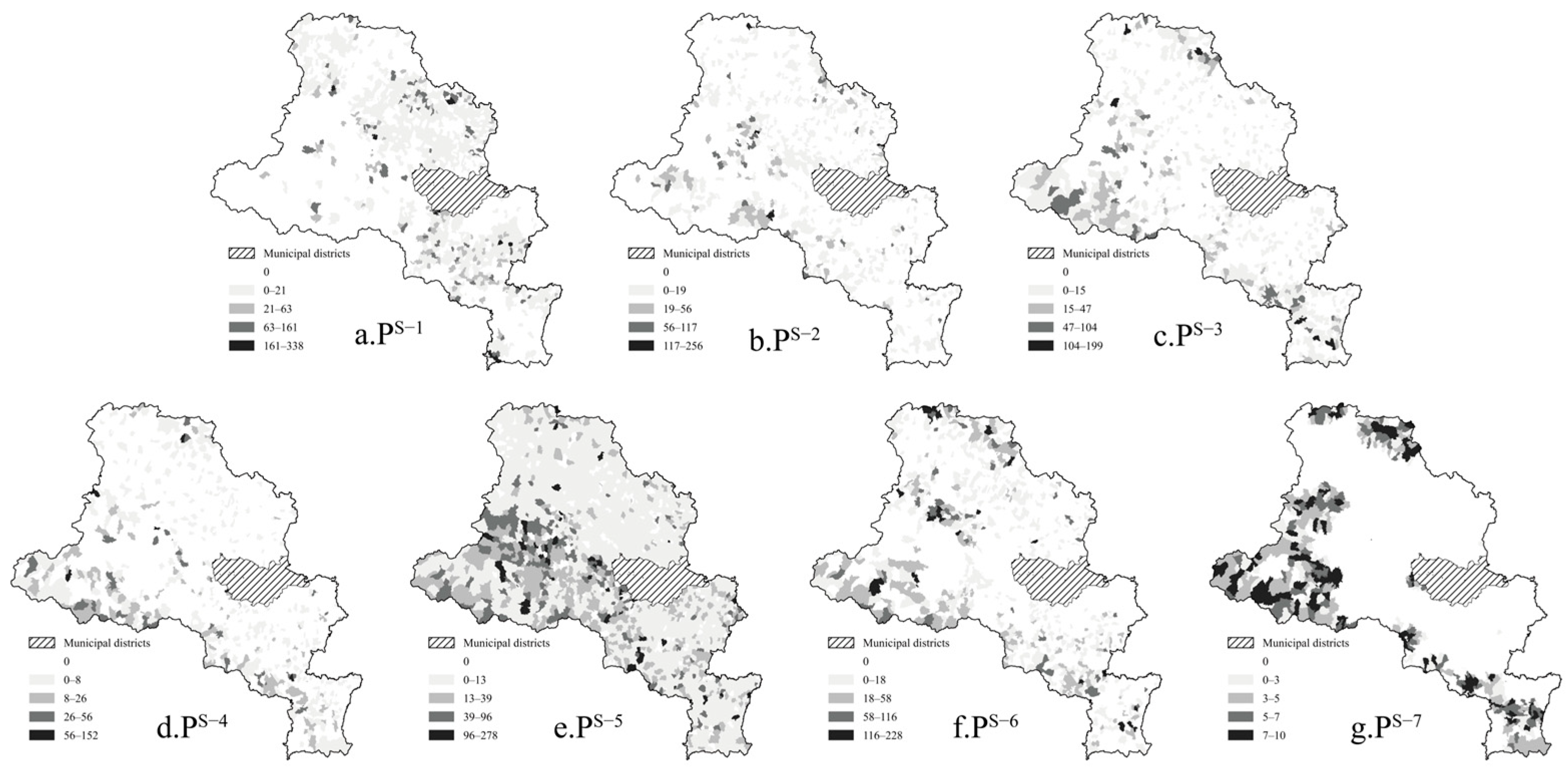
3.3. Identification of Poverty Alleviation and Development Path Features
3.4. Characteristics of Typical Poverty Alleviation and Development Paths
4. Discussion and Implications
4.1. Mechanisms of Pathways to Stable Poverty Alleviation
- (1)
- The process of achieving stable poverty alleviation consistently centers on the fundamental goal of eradicating poverty (Figure 18). Accurate identification of households’ initial poverty characteristics is a prerequisite for formulating effective policies and implementing targeted interventions. During China’s stage of Targeted Poverty Alleviation, the standard of poverty identification was established as the basic criterion for evaluating household poverty status [59,60]. This standard consisted of two major aspects: the minimum guarantee of basic living conditions, including food and essential daily necessities; and the assurance of access to fundamental public services, particularly in education, healthcare, and housing.
- (2)
- Achieving stable poverty alleviation not only requires mitigating or eliminating poverty itself, but also relies on stable Livelihood to sustain continuous improvements in living standards. From the perspective of livelihood development, two types can be distinguished: Social Protection Measures and Industry-Assisted Measures.
- (3)
- From an overall perspective (Figure 18), the internal mechanisms through which rural households achieve stable poverty alleviation can be broadly categorized into two dimensions: “poverty alleviation” and “livelihood development.” First, poverty alleviation is guided by multidimensional poverty standards, which provide the basis for targeted interventions. Its primary focus is on reducing household burdens—particularly those related to healthcare, education, and dependency—and on improving basic living conditions such as safe drinking water and housing security. Second, livelihood development represents the core pathway for sustained income growth and long-term stability. This includes Social Protection Measures for households with special needs or disadvantaged environments, as well as Industry-Assisted Measures that support diversified pathways in agriculture, agro-processing, and rural services. Overall, while targeted poverty alleviation reduces immediate burdens, livelihood development determines households’ ability to sustain poverty reduction. The interaction of these two dimensions—protective transfers and endogenous development—constitutes the fundamental mechanism through which stable poverty alleviation evolves into sustainable, long-term resilience.
4.2. Spatial Heterogeneity and Underlying Mechanisms of Household Poverty Alleviation Pathways
4.3. Research Limitations and Future Directions
5. Conclusions
- Introducing the concept of household poverty alleviation and development pathways, which integrates both “poverty states” and ‘process dynamics’. This conceptualization addresses the temporal fragmentation problem in existing studies that analyze either states or processes in isolation, and enables a more comprehensive understanding of the dynamic evolution of poverty alleviation and development;
- Constructing an explainable machine learning framework that combines XGBoost and SHAP methods to identify the evolutionary features of household “state–process” transitions, providing a methodological foundation for analyzing the mechanisms of poverty alleviation and development;
- Empirically validating the framework with large-scale household monitoring data to reveal fine-grained differences in state transitions and pathway choices;
- Analyzing the role of policy measures during China’s targeted poverty alleviation phase, thereby linking empirical findings with theoretical insights.
- Building on this foundation, the analysis yields several key findings regarding pathway dynamics:
Author Contributions
Funding
Institutional Review Board Statement
Informed Consent Statement
Data Availability Statement
Conflicts of Interest
Appendix A
| Dimension | Indicator Code | Indicator | Calculation Method | Feature Value |
|---|---|---|---|---|
| Living Burdens | A1 | Chronic Disease Burden | Proportion of household members with chronic illness | 1: [0, 0.2), 2: [0.2, 0.4), 3: [0.4, 0.6), 4: [0.6, 0.8), 5: [0.8, 1.0] |
| A2 | Major Illness Burden | Proportion of household members with serious illness | 1: [0, 0.2), 2: [0.2, 0.4), 3: [0.4, 0.6), 4: [0.6, 0.8), 5: [0.8, 1.0] | |
| A3 | Disability Burden | Proportion of household members with disabilities | 1: [0, 0.2), 2: [0.2, 0.4), 3: [0.4, 0.6), 4: [0.6, 0.8), 5: [0.8, 1.0] | |
| A4 | Major Illness Medical Coverage | Proportion of household members participating in serious-illness medical schemes | 1: [0, 0.2), 2: [0.2, 0.4), 3: [0.4, 0.6), 4: [0.6, 0.8), 5: [0.8, 1.0] | |
| A5 | Compulsory Education Enrollment Rate | Proportion of population enrolled in compulsory education | 1: [0, 0.2), 2: [0.2, 0.4), 3: [0.4, 0.6), 4: [0.6, 0.8), 5: [0.8, 1.0] | |
| A6 | Higher Education Enrollment Rate | Proportion of population enrolled in higher education | 1: [0, 0.2), 2: [0.2, 0.4), 3: [0.4, 0.6), 4: [0.6, 0.8), 5: [0.8, 1.0] | |
| A7 | School-Age Enrollment Rate | Proportion of school-age children enrolled | 1: [0, 0.2), 2: [0.2, 0.4), 3: [0.4, 0.6), 4: [0.6, 0.8), 5: [0.8, 1.0] | |
| A8 | Enrollment Share of Population | Proportion of household population currently in school | 1: [0, 0.2), 2: [0.2, 0.4), 3: [0.4, 0.6), 4: [0.6, 0.8), 5: [0.8, 1.0] | |
| A9 | Dependency Ratio | Ratio of non-working-age population to working-age population | 1: Low Dependency Ratio Household (≤0.5), 2: Medium Dependency Ratio Household (0.5−1), 3: High Dependency Ratio Household (≥1), 4: Household Without Labor Force | |
| Housing & Infrastructure | B1 | Housing Safety | Household in dilapidated housing (yes/no) | 1: True, 2: False |
| B2 | Residential Electricity Access | Household with residential electricity (yes/no) | 1: True, 2: False | |
| B3 | Dilapidated Housing Renovation Project | Number of times household participated in dilapidated-housing renovation programs | 0, 1, 2, 3 | |
| B4 | Safe Drinking Water Access | Household with safe drinking water access (yes/no) | 1: True, 2: False | |
| Human Capital | C1 | Household Size | Total number of household members | 1, 2, 3, 4, 5, 6, ≥7 |
| C2 | Family Structure Type | Categorical family structure type | Single-Parent Nuclear Family, Single-Person Household, Composite Family, Standard Nuclear Family, Extended Family (Direct Lineage), Skip-Generation Family | |
| C3 | Gender Ratio | Proportion of male members in the household | 1: [0, 0.2), 2: [0.2, 0.4), 3: [0.4, 0.6), 4: [0.6, 0.8), 5: [0.8, 1.0] | |
| C4 | Ethnic Minority Share | Proportion of ethnic minority members | 1: [0, 0.2), 2: [0.2, 0.4), 3: [0.4, 0.6), 4: [0.6, 0.8), 5: [0.8, 1.0] | |
| C5 | Education Level of Labor Force | Average years of schooling of working-age members | 1: [0, 3), 2: [3, 6), 3: [6, 9), 4: [9, 12), 5: [12, 15), 6: [15, +∞) | |
| C6 | Skilled Labor Share | Proportion of labor force with vocational/technical skills | 1: [0, 0.2), 2: [0.2, 0.4), 3: [0.4, 0.6), 4: [0.6, 0.8), 5: [0.8, 1.0] | |
| C7 | Mandarin Proficiency Coverage | Household members able to speak Mandarin (yes/no) | 1: [0, 0.2), 2: [0.2, 0.4), 3: [0.4, 0.6), 4: [0.6, 0.8), 5: [0.8, 1.0] | |
| C8 | Participation in Education Aid Programs | Number of times household participated in education poverty-alleviation programs | 0, 1, 2, 3, 4, 5 | |
| Production Resources | D1 | Cultivated Land Area (mu) | Total cultivated land area (mu) | 1: [0, 3), 2: [3, 6), 3: [6, 9), 4: [9, 12), 5: [12, 15), 6: [15, +∞) |
| D2 | Other Agricultural Land Area (mu) | Total other agricultural land area (mu) | 1: [0, 3), 2: [3, 6), 3: [6, 9), 4: [9, 12), 5: [12, 15), 6: [15, +∞) | |
| D3 | Access Road Type | Type of household access road | 1: Dirt Road, 2: Gravel Road, 3: Paved Road | |
| D4 | Distance to Main Village Road (km) | Distance from household to main village road (km) | 1: [0, 0.5), 2: [0.5, 1), 3: [1, 1.5), 4: [1.5, 2), 5: [2, +∞) | |
| D5 | Production Electricity Access | Household with production-use electricity (yes/no) | 1: True, 2: False | |
| D6 | Village Poverty Exit Status | Whether the village has been lifted out of poverty (yes/no) | 1: True, 2: False | |
| Social Protection Measures | E1 | Allowance for Needy Families | Number of household members receiving minimum living allowance | 0, 1, 2, 3, 4, 5, 6 |
| E2 | Public Welfare Employment Participation | Number of times household participated in public welfare job programs | 0, 1, 2, 3, 4 | |
| E3 | Photovoltaic Project Participation | Number of times household participated in photovoltaic projects | 0, 1, 2, 3, 4, 5 | |
| E4 | Ecological Compensation Participation | Number of times household participated in ecological compensation programs | 0, 1 | |
| Industry-Assisted Measures | F1 | Agricultural Planting Assistance | Number of times household participated in agricultural planting support programs | 0, 1, 2, 3, 4, 5, 6 |
| F2 | Agro-processing Assistance | Number of times household participated in agro-processing support programs | 0, 1, 2, 3, 4, 5, 6 | |
| F3 | Rural Tourism & Leisure Agriculture Programs Participation | Number of times household participated in rural tourism/leisure agriculture projects | 0, 1, 2, 3, 4 | |
| Labor & Income | G1 | Average Annual Work-Months | Average number of months per year that household labor force works away | 1: [0, 3), 2: [3, 6), 3: [6, 9), 4: [9, 12), 5: [12, +∞) |
| G2 | Per Capita Net Income | Household net income per capita | 1: [0, 1), 2: [1, 3), 3: [3, 5), 4: [5, 8), 5: [8, 11), 6: [11, 14), 7: [14, 20), 8: [20, 25), 9: [25, +∞) |
| Model | Key Hyperparameters | Value | Description |
|---|---|---|---|
| XGBoost | objective | multi:softprob | Multi-class classification with probability outputs |
| num_class | 3 | Three poverty states | |
| learning_rate | 0.05 | Step size shrinkage | |
| max_depth | 8 | Maximum tree depth | |
| n_estimators | 200 | Number of boosting rounds | |
| early_stopping_rounds | 20 | Early stopping patience | |
| subsample | 0.8 | Data sampling ratio | |
| colsample_bytree | 0.8 | Feature sampling ratio | |
| lambda | 1 | L2 regularization term | |
| tree_method | hist | Histogram-based algorithm | |
| device | cuda | GPU acceleration | |
| Random Forest | n_estimators | 100 | Number of trees in the forest |
| max_depth | 15 | Maximum tree depth | |
| min_samples_split | 5 | Minimum samples required to split | |
| random_state | 42 | Random seed for reproducibility | |
| Decision Tree | max_depth | 10 | Maximum tree depth |
| min_samples_leaf | 4 | Minimum samples at leaf node | |
| random_state | 42 | Random seed for reproducibility |
References
- United Nations. The Sustainable Development Goals Report 2023; United Nations: New York, NY, USA, 2023. [Google Scholar]
- Sachs, J.D. The Age of Sustainable Development; Columbia University Press: New York, NY, USA, 2015; 544p, ISBN 978-0-231-17314-8. [Google Scholar]
- UNDP; OPHI. Global Multidimensional Poverty Index 2024: Poverty Amid Conflict; United Nations Development Programme: New York, NY, USA; Oxford Poverty and Human Development Initiative: Oxford, UK, 2024. [Google Scholar]
- Saccone, D.; Vallino, E. Global Food Security in a Turbulent World: Reviewing the Impacts of the Pandemic, the War and Climate Change. Agric. Food Econ. 2025, 13, 47. [Google Scholar] [CrossRef]
- Desalegn, G.; Ali, S.N. Review of the Impact of Productive Safety Net Program (PSNP) on Rural Welfare in Ethiopia; Center for Development Research, University of Bonn: Bonn, Germany, 2018. [Google Scholar] [CrossRef]
- Abay, K.A.; Abay, M.H.; Berhane, G.; Chamberlin, J. Social Protection and Resilience: The Case of the Productive Safety Net Program in Ethiopia. Food Policy 2022, 112, 102367. [Google Scholar] [CrossRef]
- Li, E.; Deng, Q.; Zhou, Y. Livelihood Resilience and the Generative Mechanism of Rural Households out of Poverty: An Empirical Analysis from Lankao County, Henan Province, China. J. Rural Stud. 2022, 93, 210–222. [Google Scholar] [CrossRef]
- Ravallion, M. Poverty Comparisons. In Fundamentals of Pure and Applied Economics; Harwood Academic Publishers: Chur, Switzerland, 1994; Volume 56. [Google Scholar]
- Lipton, M.; Ravallion, M. Poverty and Policy. In Handbook of Development Economics; Behrman, J., Srinivasan, T.N., Eds.; Elsevier: Amsterdam, The Netherlands, 1995; Volume 3B, pp. 2551–2657. [Google Scholar]
- Laderchi, C.R.; Saith, R.; Stewart, F. Does It Matter That We Do Not Agree on the Definition of Poverty? A Comparison of Four Approaches. Oxf. Dev. Stud. 2003, 31, 243–284. [Google Scholar] [CrossRef]
- Townsend, P. Poverty in the United Kingdom: A Survey of Household Resources and Standards of Living; University of California Press: Berkeley, CA, USA, 1979. [Google Scholar]
- Foster, J.E. Absolute versus Relative Poverty. Am. Econ. Rev. 1998, 88, 335–341. [Google Scholar]
- Ravallion, M.; Chen, S. Global Poverty Measurement When Relative Income Matters. J. Public Econ. 2019, 177, 104046. [Google Scholar] [CrossRef]
- Sen, A. Inequality Reexamined; Clarendon Press: Oxford, UK, 1995. [Google Scholar]
- Sen, A. Development as Freedom; Alfred A. Knopf Inc.: New York, NY, USA, 1999. [Google Scholar]
- Sen, A. The Idea of Justice; Allen Lane: London, UK, 2009. [Google Scholar]
- Liu, M.; Yuan, L.; Zhao, Y. Risk of Returning to Multidimensional Poverty and Its Influencing Factors among Relocated Households for Poverty Alleviation in China. Agriculture 2024, 14, 954. [Google Scholar] [CrossRef]
- Li, C. Vulnerability and Livelihood Restoration of Landless Households after Land Acquisition: Evidence from Peri-Urban China. Habitat Int. 2018, 79, 109–115. [Google Scholar] [CrossRef]
- Liu, T.; Yu, L.; Chen, X.; Li, X.; Du, Z.; Yan, Y.; Peng, D.; Gong, P. Utilizing Nighttime Light Datasets to Uncover the Spatial Patterns of County-Level Relative Poverty-Returning Risk in China and Its Alleviating Factors. J. Clean. Prod. 2024, 448, 141682. [Google Scholar] [CrossRef]
- Zhou, D.; Cai, K.; Zhong, S. A Statistical Measurement of Poverty Reduction Effectiveness: Using China as an Example. Soc. Indic. Res. 2021, 153, 39–64. [Google Scholar] [CrossRef]
- Wang, H.; Huang, W.; Yu, Z.; Han, J. Prediction and Pattern Recognition of the Large-Scale Poverty-Returning Risks: Empirical Evidence from Machine Learning. Int. Food Agribus. Manag. Rev. 2024, 28, 357–374. [Google Scholar] [CrossRef]
- Liu, W.; Liu, J.; Xu, J.; Li, J.; Feldman, M. Examining the Links between Household Livelihood Resilience and Vulnerability: Disaster Resettlement Experience from Rural China. Front. Environ. Sci. 2024, 11, 1340113. [Google Scholar] [CrossRef]
- Bonanno, G.; Chies, L.; Podrecca, E. The Determinants of Poverty Exits and Entries and the Role of Social Benefits: The Italian Case. Econ. Polit. 2023, 40, 931–969. [Google Scholar] [CrossRef]
- Ge, Y.; Liu, M.; Hu, S.; Ren, Z. The Application and Prospect of Spatiotemporal Statistics in Poverty Research. J. Geo-Inf. Sci. 2021, 23, 58–74. [Google Scholar] [CrossRef]
- Zhou, Y.; Liu, Y. The Geography of Poverty: Review and Research Prospects. J. Rural Stud. 2022, 93, 408–416. [Google Scholar] [CrossRef]
- Alkire, S.; Foster, J. Counting and Multidimensional Poverty Measurement. J. Public Econ. 2011, 95, 476–487. [Google Scholar] [CrossRef]
- Alkire, S.; Santos, M.E. Measuring Acute Poverty in the Developing World: Robustness and Scope of the Multidimensional Poverty Index. World Dev. 2014, 59, 251–274. [Google Scholar] [CrossRef]
- D’Attoma, I.; Matteucci, M. Multidimensional Poverty: An Analysis of Definitions, Measurement Tools, Applications and Their Evolution over Time through a Systematic Review of the Literature up to 2019. Qual. Quant. 2024, 58, 3171–3213. [Google Scholar] [CrossRef]
- Zou, W.; Cheng, X.; Fan, Z.; Yin, W. Multidimensional Relative Poverty in China: Identification and Decomposition. Sustainability 2023, 15, 4869. [Google Scholar] [CrossRef]
- Wang, B.; Luo, Q.; Chen, G.; Zhang, Z.; Jin, P. Differences and Dynamics of Multidimensional Poverty in Rural China from Multiple Perspectives Analysis. J. Geogr. Sci. 2022, 32, 1383–1404. [Google Scholar] [CrossRef]
- Wardana, W.W.; Sari, D.W. Dynamic Poverty Study: Chronic and Transient Poverty in Indonesia. Int. J. Innov. Creat. Change 2020, 11, 600–622. [Google Scholar]
- Ding, J.; Leng, Z. Regional Poverty Analysis in a View of Geography Science. Acta Geogr. Sin. 2018, 73, 232–247. [Google Scholar] [CrossRef]
- Sachs, J.D. The End of Poverty; Penguin Press: New York, NY, USA, 2005. [Google Scholar]
- Luo, X.; Zhang, Z.; Wan, Q.; Jin, G. Spatial Poverty Traps in Rural China: Aggregation, Persistence, and Reinforcement. Area 2021, 53, 56–66. [Google Scholar] [CrossRef]
- Liu, M.; Ge, Y.; Hu, S.; Hao, H. The Spatial Effects of Regional Poverty: Spatial Dependence, Spatial Heterogeneity and Scale Effects. ISPRS Int. J. Geo-Inf. 2023, 12, 501. [Google Scholar] [CrossRef]
- Liu, Y.; Liu, J.; Zhou, Y. Spatio-Temporal Patterns of Rural Poverty in China and Targeted Poverty Alleviation Strategies. J. Rural Stud. 2017, 52, 66–75. [Google Scholar] [CrossRef]
- Fan, C.C.; Sun, M. Regional Inequality in China, 1978–2006. Eurasian Geogr. Econ. 2008, 49, 1–18. [Google Scholar] [CrossRef]
- Jalan, J.; Ravallion, M. Geographic Poverty Traps? A Micro Model of Consumption Growth in Rural China. J. Appl. Econom. 2002, 17, 329–346. [Google Scholar] [CrossRef]
- Ellis, F. Rural Livelihoods and Diversity in Developing Countries; Oxford University Press: Oxford, UK, 2000; ISBN 978-0-19-829696-6. [Google Scholar]
- Scoones, I. Sustainable Rural Livelihoods: A Framework for Analysis; Institute of Development Studies: Brighton, UK, 1998. [Google Scholar]
- Long, H.; Liu, Y.; Li, X.; Chen, Y. Building New Countryside in China: A Geographical Perspective. Land Use Policy 2010, 27, 457–470. [Google Scholar] [CrossRef]
- Hall, O.; Dompae, F.; Wahab, I.; Dzanku, F.M. A Review of Machine Learning and Satellite Imagery for Poverty Prediction: Implications for Development Research and Applications. J. Int. Dev. 2023, 35, 1753–1768. [Google Scholar] [CrossRef]
- Jean, N.; Burke, M.; Xie, M.; Davis, W.M.; Lobell, D.B.; Ermon, S. Combining Satellite Imagery and Machine Learning to Predict Poverty. Science 2016, 353, 790–794. [Google Scholar] [CrossRef]
- Shi, K.; Chang, Z.; Chen, Z.; Wu, J.; Yu, B. Identifying and Evaluating Poverty Using Multisource Remote Sensing and Point of Interest (POI) Data: A Case Study of Chongqing, China. J. Clean. Prod. 2020, 255, 120245. [Google Scholar] [CrossRef]
- Sohnesen, T.P.; Stender, N. Is Random Forest a Superior Methodology for Predicting Poverty? An Empirical Assessment. Poverty Public Policy 2017, 9, 118–133. [Google Scholar] [CrossRef]
- Zhao, X.; Yu, B.; Liu, Y.; Chen, Z.; Li, Q.; Wang, C.; Wu, J. Estimation of Poverty Using Random Forest Regression with Multi-Source Data: A Case Study in Bangladesh. Remote Sens. 2019, 11, 375. [Google Scholar] [CrossRef]
- Head, A.; Manguin, M.; Tran, N.; Blumenstock, J.E. Can Human Development Be Measured with Satellite Imagery? In Proceedings of the Ninth International Conference on Information and Communication Technologies and Development, Lahore, Pakistan, 16–19 November 2017; Association for Computing Machinery: New York, NY, USA, 2017; pp. 1–11. [Google Scholar]
- Huang, L.Y.; Hsiang, S.; Gonzalez-Navarro, M. Using Satellite Imagery and Deep Learning to Evaluate the Impact of Anti-Poverty Programs. SSRN Electron. J. 2021. [Google Scholar] [CrossRef]
- Dave, D.; Naik, H.; Singhal, S.; Patel, P. Explainable AI Meets Healthcare: A Study on Heart Disease Dataset. arXiv 2020. [Google Scholar] [CrossRef]
- Ribeiro, M.T.; Singh, S.; Guestrin, C. “Why Should I Trust You?”: Explaining the Predictions of Any Classifier. arXiv 2016. [Google Scholar] [CrossRef]
- Lundberg, S.M.; Lee, S.-I. A Unified Approach to Interpreting Model Predictions. In Proceedings of the 31st International Conference on Neural Information Processing Systems (NIPS 2017), Long Beach, CA, USA, 4–9 December 2017; Curran Associates, Inc.: Red Hook, NY, USA, 2017; pp. 4768–4777. [Google Scholar]
- O’Brien Quinn, H.; Sedky, M.; Francis, J.; Streeton, M. Literature Review of Explainable Tabular Data Analysis. Electronics 2024, 13, 3806. [Google Scholar] [CrossRef]
- Loh, H.W.; Ooi, C.P.; Seoni, S.; Barua, P.D.; Molinari, F.; Acharya, U.R. Application of Explainable Artificial Intelligence for Healthcare: A Systematic Review of the Last Decade (2011–2022). Comput. Methods Programs Biomed. 2022, 226, 107161. [Google Scholar] [CrossRef]
- Li, Y.; Yan, K. Prediction of Bank Credit Customers Churn Based on Machine Learning and Interpretability Analysis. Data Sci. Finance Econ. 2025, 5, 19–34. [Google Scholar] [CrossRef]
- Aas, K.; Jullum, M.; Løland, A. Explaining Individual Predictions When Features Are Dependent: More Accurate Approximations to Shapley Values. Artif. Intell. 2021, 298, 103502. [Google Scholar] [CrossRef]
- Li, Z. Extracting Spatial Effects from Machine Learning Model Using Local Interpretation Method: An Example of SHAP and XGBoost. Comput. Environ. Urban Syst. 2022, 96, 101845. [Google Scholar] [CrossRef]
- Alkire, S.; Seth, S. Multidimensional Poverty Reduction in India between 1999 and 2006: Where and How? World Dev. 2015, 72, 93–108. [Google Scholar] [CrossRef]
- Banerjee, A.V.; Duflo, E.; Kremer, M. The Influence of Randomized Controlled Trials on Development Economics Research and on Development Policy. In The State of Economics, the State of the World; Basu, K., Rosenblatt, D., Sepúlveda, C., Eds.; The MIT Press: Cambridge, MA, USA, 2020; pp. 439–487. ISBN 978-0-262-35347-2. [Google Scholar]
- Guo, Y.; Zhou, Y.; Liu, Y. Targeted Poverty Alleviation and Its Practices in Rural China: A Case Study of Fuping County, Hebei Province. J. Rural Stud. 2022, 93, 430–440. [Google Scholar] [CrossRef]
- Long, H.; Tu, S.; Ge, D.; Li, T.; Liu, Y. The Allocation and Management of Critical Resources in Rural China under Restructuring: Problems and Prospects. J. Rural Stud. 2016, 47, 392–412. [Google Scholar] [CrossRef]
- Liu, Y.; Li, Y. Revitalize the World’s Countryside. Nature 2017, 548, 275–277. [Google Scholar] [CrossRef]
- Long, H.; Zou, J.; Liu, Y. Differentiation of Rural Development Driven by Industrialization and Urbanization in Eastern Coastal China. Habitat Int. 2009, 33, 454–462. [Google Scholar] [CrossRef]
- Douglass, M. The Saemaul Undong in Historical Perspective and in the Contemporary World. In Learning from the South Korean Developmental Success: Effective Developmental Cooperation and Synergistic Institutions and Policies; Yi, I., Mkandawire, T., Eds.; Palgrave Macmillan UK: London, UK, 2014; pp. 136–171. ISBN 978-1-137-33948-5. [Google Scholar]
- Xinhua News Agency. Poverty Alleviation: China’s Experience and Contribution; The State Council Information Office of the People’s Republic of China: Beijing, China, 2021. [Google Scholar]
- Yip, W.; Hsiao, W.C. What Drove the Cycles of Chinese Health System Reforms? Health Syst. Reform 2015, 1, 52–61. [Google Scholar] [CrossRef]
- Hannum, E.; Wang, M. Geography and Educational Inequality in China. China Econ. Rev. 2006, 17, 253–265. [Google Scholar] [CrossRef]
- Tao, W.; Zeng, Z.; Dang, H.; Lu, B.; Chuong, L.; Yue, D.; Wen, J.; Zhao, R.; Li, W.; Kominski, G.F. Towards Universal Health Coverage: Lessons from 10 Years of Healthcare Reform in China. BMJ Glob. Health 2020, 5, e002086. [Google Scholar] [CrossRef]
- Gao, Q.; Garfinkel, I.; Zhai, F. Anti-Poverty Effectiveness of the Minimum Living Standard Assistance Policy in Urban China. Rev. Income Wealth 2009, 55, 630–655. [Google Scholar] [CrossRef]
- Tesfay, G.; Berhane, G.; Hoddinott, J.; Kumar, N. The Impact of Ethiopia’s Productive Safety Net Programme on the Nutritional Status of Children: 2008–2012; International Food Policy Research Institute (IFPRI): Washington, DC, USA, 2017. [Google Scholar]
- Gilligan, D.O.; Hoddinott, J.; Taffesse, A.S. The Impact of Ethiopia’s Productive Safety Net Programme and Its Linkages. J. Dev. Stud. 2009, 45, 1684–1706. [Google Scholar] [CrossRef]
- Huan, Q.; Chen, Y.; Huan, X. A Frugal Eco-Innovation Policy? Ecological Poverty Alleviation in Contemporary China from a Perspective of Eco-Civilization Progress. Sustainability 2022, 14, 4570. [Google Scholar] [CrossRef]
- Tao, Y.; Wu, Y.; Wu, M.; Luo, X.; He, F.; Gao, R.; Zhang, L. Multi-Criteria Decision Making for Comprehensive Benefits Assessment of Photovoltaic Poverty Alleviation Project under Sustainability Perspective: A Case Study in Yunnan, China. J. Clean. Prod. 2022, 346, 131175. [Google Scholar] [CrossRef]
- Huang, F.; Wang, Z.; Liu, J.; Shuai, C.; Li, W. Exploring Rural Energy Choice from the Perspective of Multi-Dimensional Capabilities: Evidence from Photovoltaic Anti-Poverty Areas in Rural China. J. Clean. Prod. 2021, 283, 124586. [Google Scholar] [CrossRef]
- Cao, S. Impact of China’s Large-Scale Ecological Restoration Program on the Environment and Society in Arid and Semiarid Areas of China: Achievements, Problems, Synthesis, and Applications. Crit. Rev. Environ. Sci. Technol. 2011, 41, 317–335. [Google Scholar] [CrossRef]
- Belcher, B.M. Forest Product Markets, Forests and Poverty Reduction. Int. For. Rev. 2005, 7, 82–89. [Google Scholar] [CrossRef]
- Barham, B.L.; Melo, A.P.; Hertz, T. Earnings, Wages, and Poverty Outcomes of US Farm and Low-Skill Workers. Appl. Econ. Perspect. Policy 2020, 42, 307–334. [Google Scholar] [CrossRef]
- Chrisinger, C.K.; Fowler, C.S.; Kleit, R.G. Shared Skills: Occupation Clusters for Poverty Alleviation and Economic Development in the US. Urban Stud. 2012, 49, 3403–3425. [Google Scholar] [CrossRef]
- Dou, Y.; Wu, J.; Li, Y.; Chen, X.; Zhao, X. Has the Development of the Non-Timber Forest Products Industry Achieved Poverty Alleviation? Evidence from Lower-Income Forest Areas in Yunnan Province. Forests 2023, 14, 776. [Google Scholar] [CrossRef]
- Yang, G.; Zhou, C.; Zhang, J. Does the Synergy among Agriculture, Industry, and the Service Industry Alleviate Rural Poverty? Evidence from China. Appl. Econ. Lett. 2023, 30, 1417–1421. [Google Scholar] [CrossRef]
- Yang, G.; Zhou, C.; Zhang, J. Does Industry Convergence between Agriculture and Related Sectors Alleviate Rural Poverty: Evidence from China. Environ. Dev. Sustain. 2023, 25, 12887–12914. [Google Scholar] [CrossRef]
- Wang, X.; Weaver, N.; You, J. The Social Security Function of Agriculture in China. J. Int. Dev. 2013, 25, 1–10. [Google Scholar] [CrossRef]
- Oladehinde, G.J.; Olayiwola, L.M.; Popoola, K.O. Security of Land Tenure: A Comparative Analysis among Sub-Ethnic Groups in Rural Communities of Oyo State, Nigeria. Land Use Policy 2024, 138, 107035. [Google Scholar] [CrossRef]
- Borras, S.M., Jr.; Carranza, D.; Franco, J.C. Anti-Poverty or Anti-Poor? The World Bank’s Market-Led Agrarian Reform Experiment in the Philippines. Third World Q. 2007, 28, 1557–1576. [Google Scholar] [CrossRef]
- Deininger, K.; Feder, G. Land Registration, Governance, and Development: Evidence and Implications for Policy. World Bank Res. Obs. 2009, 24, 233–266. [Google Scholar] [CrossRef]
- Luo, G.; Wang, B.; Luo, D.; Wei, C. Spatial Agglomeration Characteristics of Rural Settlements in Poor Mountainous Areas of Southwest China. Sustainability 2020, 12, 1818. [Google Scholar] [CrossRef]
- Wang, X. Research on Rural Households’ Poverty Vulnerability in Poor Mountainous Areas: An Empirical Analysis in the Upper Reaches of the Min River, China. Sustainability 2025, 17, 4568. [Google Scholar] [CrossRef]
- Qin, X.; Wu, H.; Shan, T. Rural Infrastructure and Poverty in China. PLoS ONE 2022, 17, e0266528. [Google Scholar] [CrossRef]
- Burlinson, A.; Giulietti, M.; Battisti, G. The Elephant in the Energy Room: Establishing the Nexus between Housing Poverty and Fuel Poverty. Energy Econ. 2018, 72, 135–144. [Google Scholar] [CrossRef]
- Zhang, X.; Sun, Y.; Gao, Y.; Dong, Y. Paths out of Poverty: Social Entrepreneurship and Sustainable Development. Front. Psychol. 2022, 13, 1062669. [Google Scholar] [CrossRef]
- Liu, J.; Yang, M.; Zhang, Z. Can Rural Cooperatives Reduce Poverty Vulnerability of Smallholder Households? Evidence from Rural Western China. Front. Sustain. Food Syst. 2023, 7, 1222455. [Google Scholar] [CrossRef]
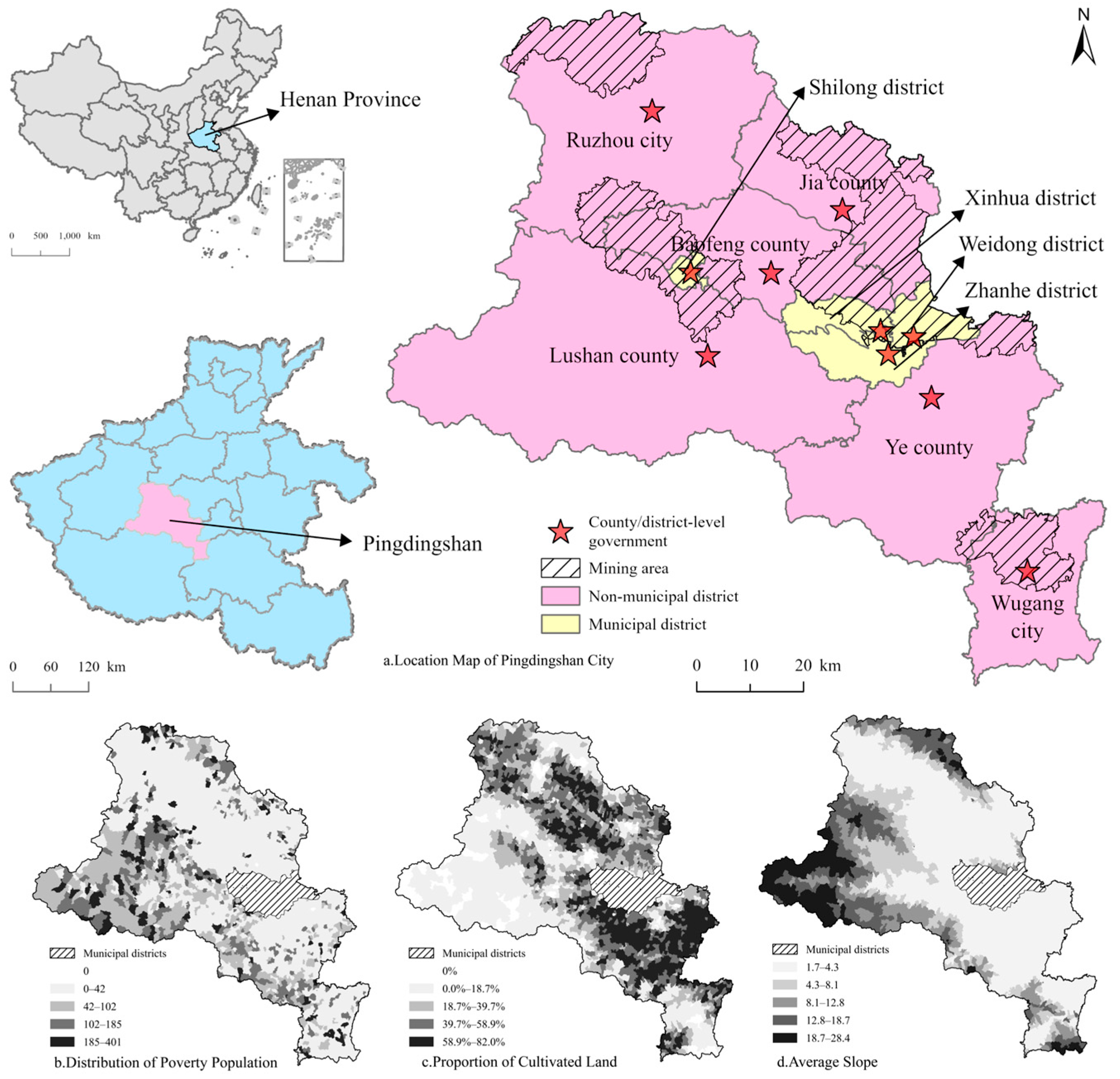
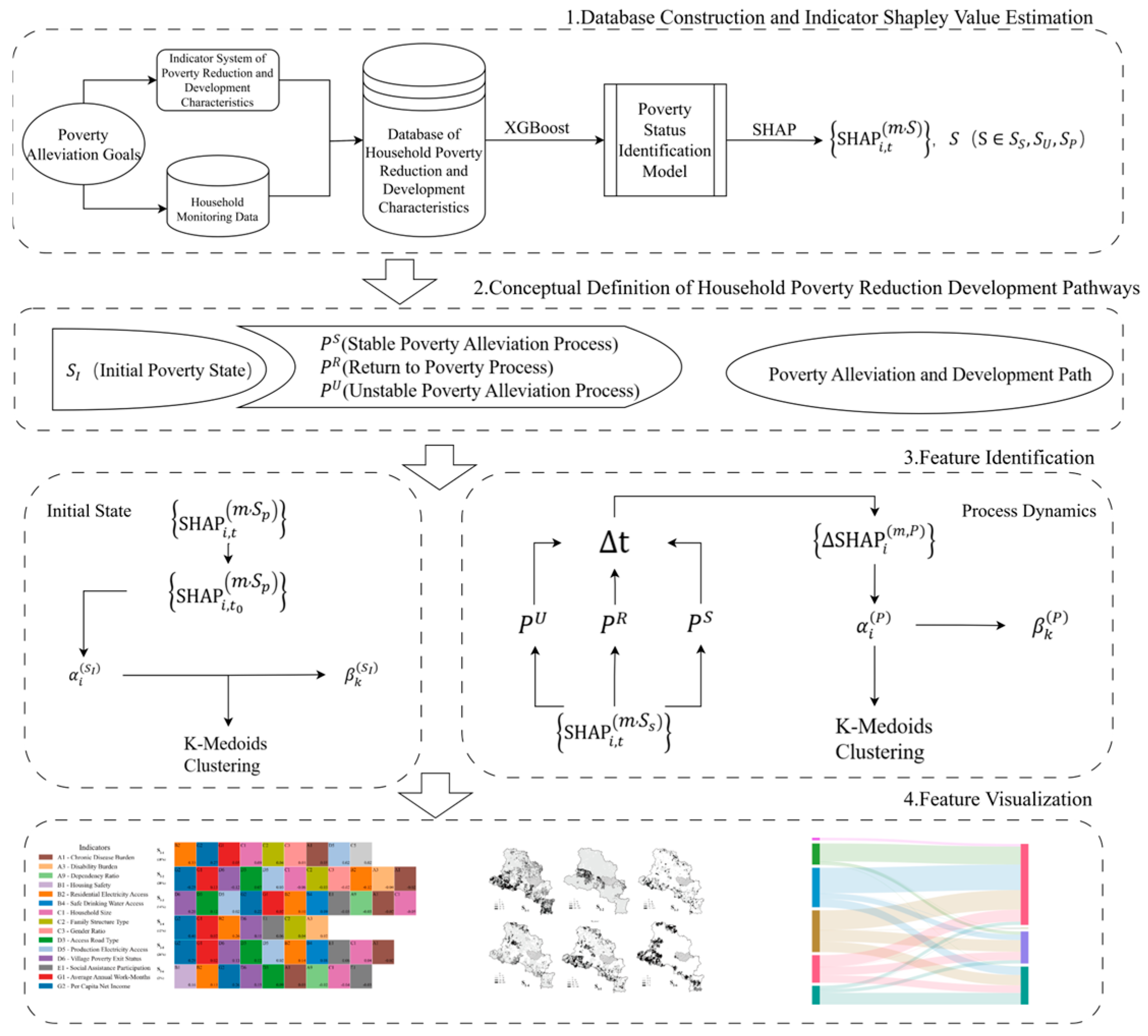



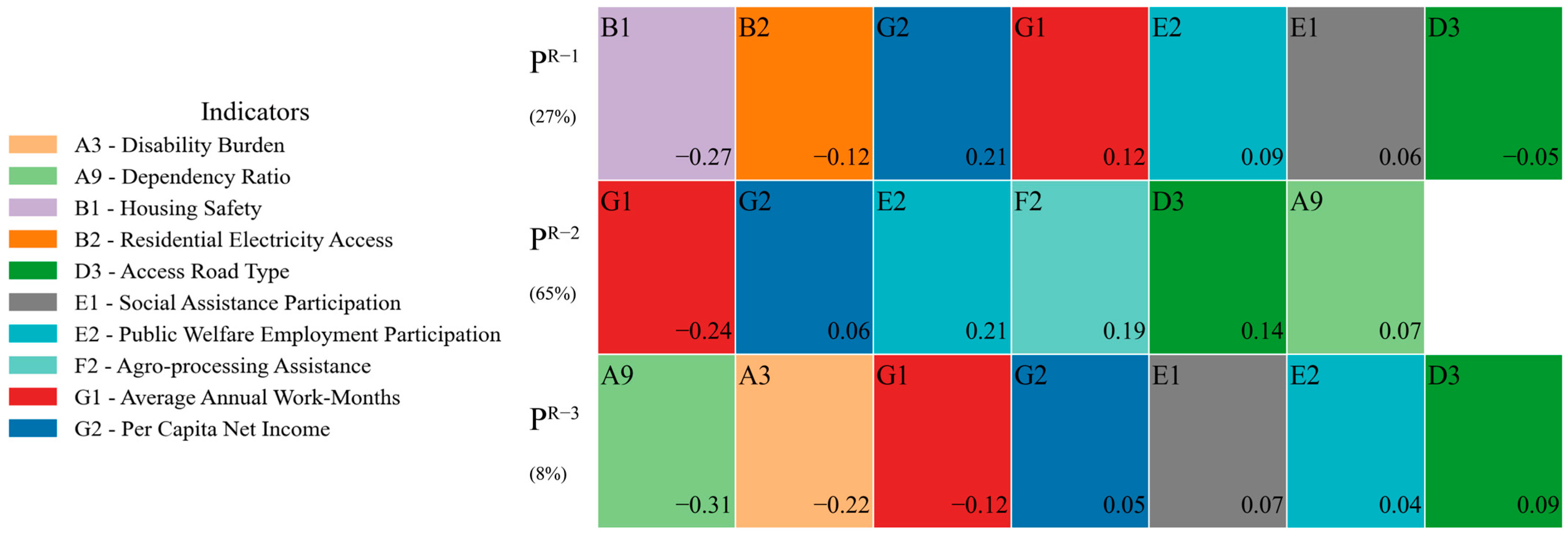




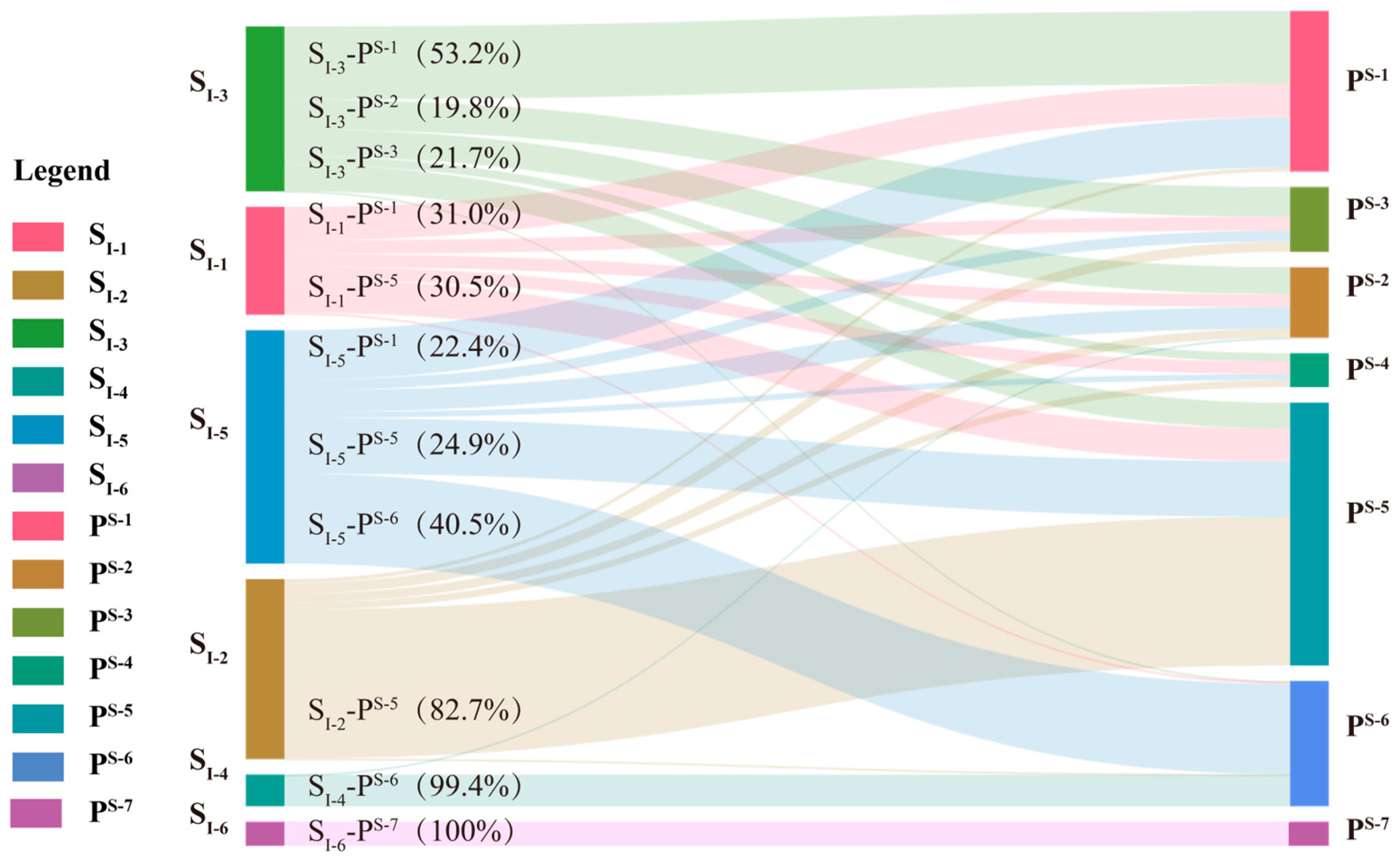

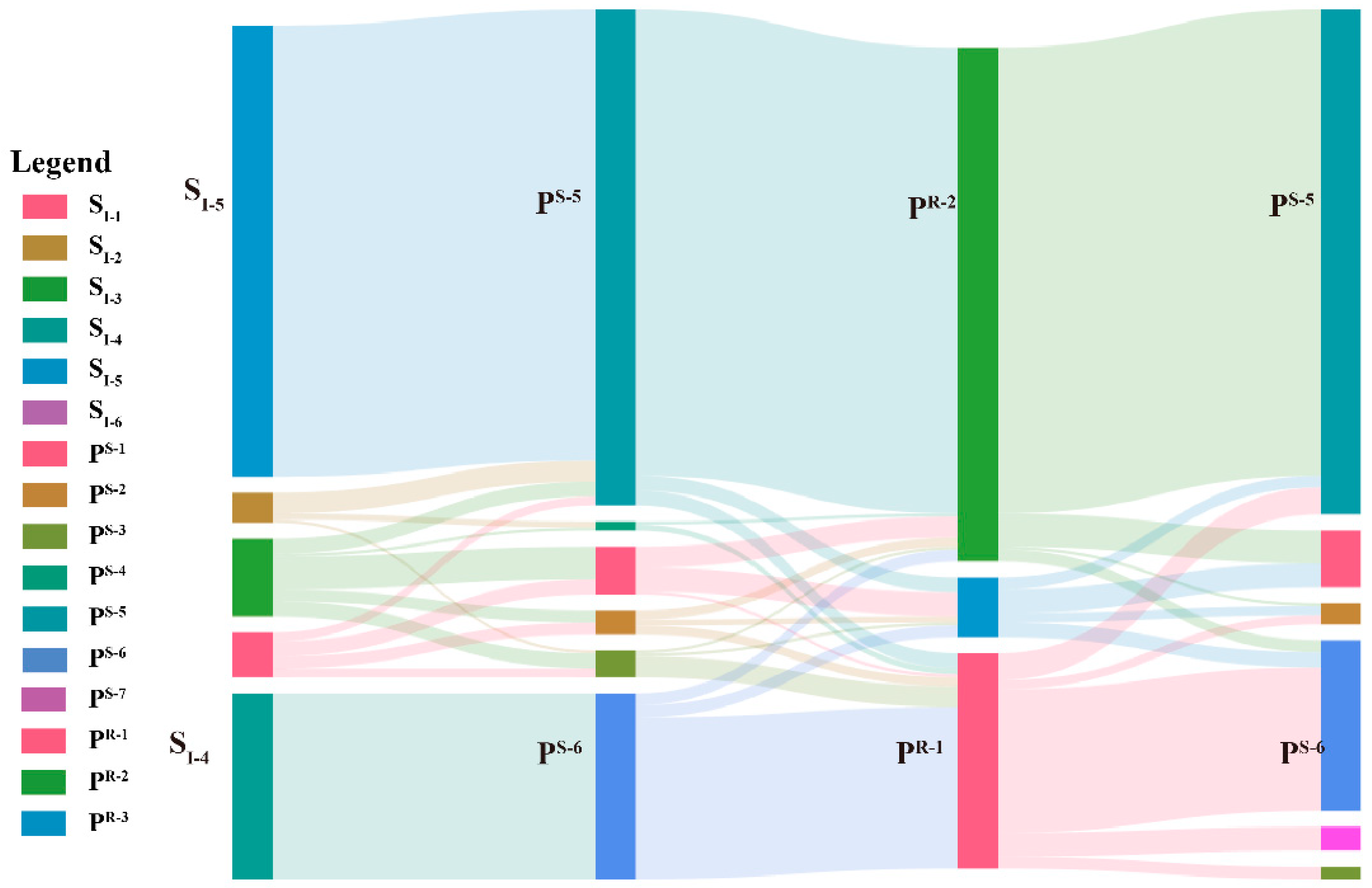
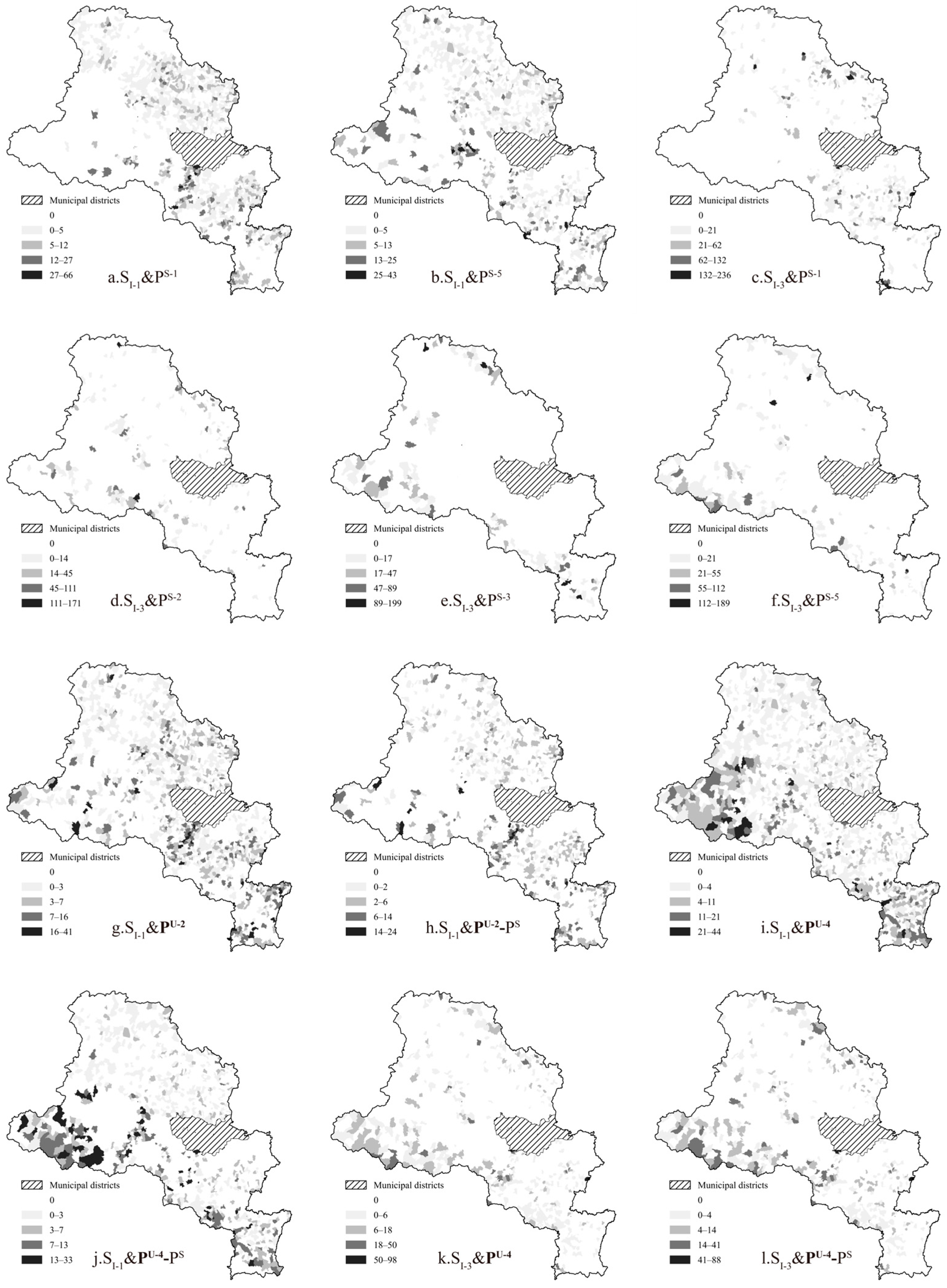

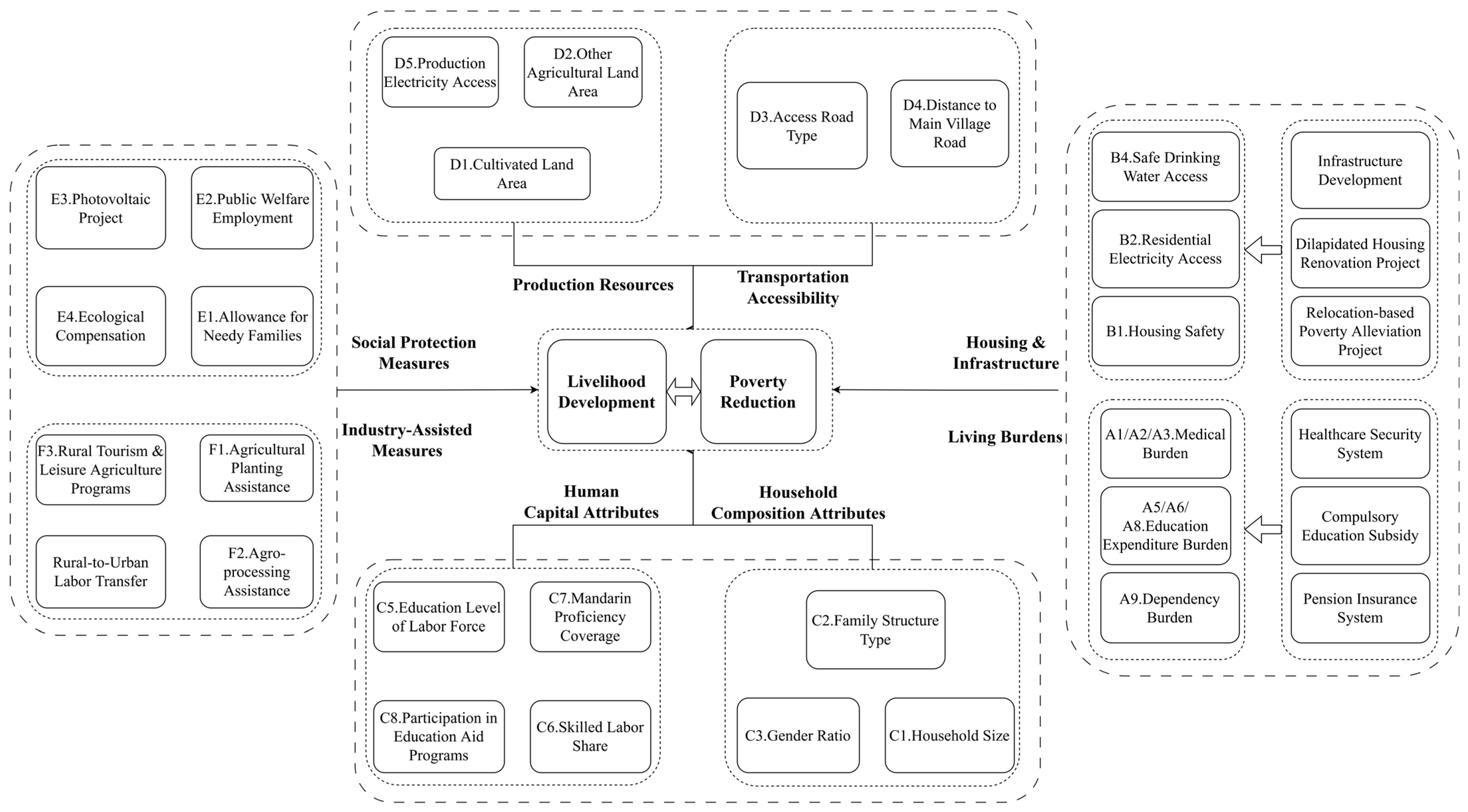
| Symbol | Type | English Term | Definition |
|---|---|---|---|
| State | Poverty State | Household has not yet escaped poverty | |
| State | Stable Poverty Alleviation State | Household has escaped poverty and is unlikely to fall back | |
| State | Unstable Poverty Alleviation State | Household has escaped poverty but remains at risk of returning | |
| State | Initial State | Household’s status when first included in monitoring and support system | |
| Process | Stable Poverty Alleviation Process | Transition from or to , with sustained stability | |
| Process | Return to Poverty Process | Transition from back to or due to internal or external shocks | |
| Process | Unstable Poverty Alleviation Process | Fluctuation between and without reaching |
Disclaimer/Publisher’s Note: The statements, opinions and data contained in all publications are solely those of the individual author(s) and contributor(s) and not of MDPI and/or the editor(s). MDPI and/or the editor(s) disclaim responsibility for any injury to people or property resulting from any ideas, methods, instructions or products referred to in the content. |
© 2025 by the authors. Licensee MDPI, Basel, Switzerland. This article is an open access article distributed under the terms and conditions of the Creative Commons Attribution (CC BY) license (https://creativecommons.org/licenses/by/4.0/).
Share and Cite
Jia, S.; Li, Q.; Zhao, W.; Wang, Y. How Do Rural Households Achieve Poverty Alleviation? Identification and Characterization of Development Pathways Using Explainable Machine Learning. Sustainability 2025, 17, 9704. https://doi.org/10.3390/su17219704
Jia S, Li Q, Zhao W, Wang Y. How Do Rural Households Achieve Poverty Alleviation? Identification and Characterization of Development Pathways Using Explainable Machine Learning. Sustainability. 2025; 17(21):9704. https://doi.org/10.3390/su17219704
Chicago/Turabian StyleJia, Shoujie, Qiong Li, Wenji Zhao, and Yanhui Wang. 2025. "How Do Rural Households Achieve Poverty Alleviation? Identification and Characterization of Development Pathways Using Explainable Machine Learning" Sustainability 17, no. 21: 9704. https://doi.org/10.3390/su17219704
APA StyleJia, S., Li, Q., Zhao, W., & Wang, Y. (2025). How Do Rural Households Achieve Poverty Alleviation? Identification and Characterization of Development Pathways Using Explainable Machine Learning. Sustainability, 17(21), 9704. https://doi.org/10.3390/su17219704





